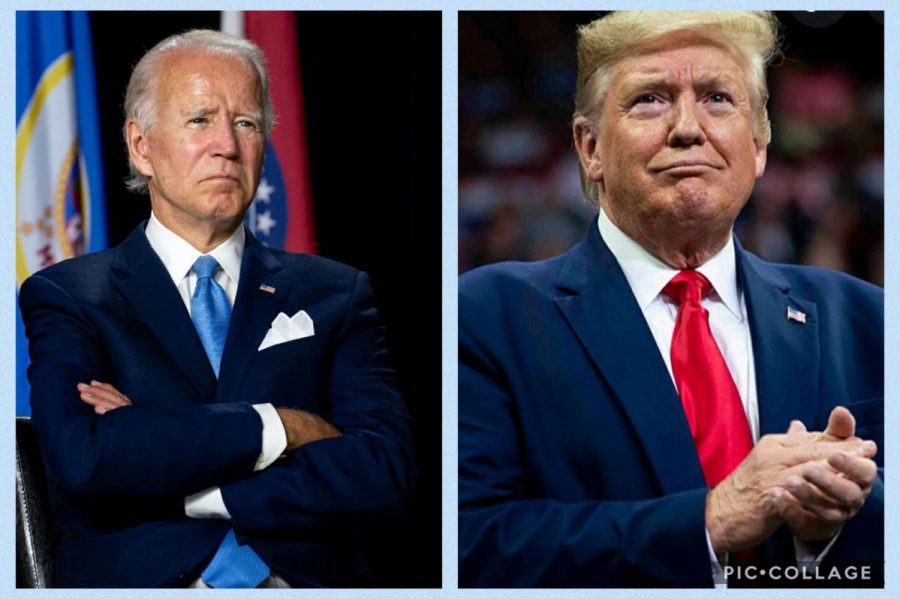BIDEN VS. TRUMP: A FINAL ANALYSIS
The United States has an election coming up on November 4th, 2020. This day will set the path that America will be taking for at least the next four years due to drastically different opinions of each candidate. (Donald J. Trump – Right) ( Joe Biden -Left-) source: nbcnews.com
November 4, 2020
As the election draws closer and people begin to vote, it is foremost to remain informed about the politics involved. Voting is an integral part of being a citizen, allowing people to have a voice in government. Taking it for granted is a foolish and selfish act to do. However, it is just as important to vote efficiently and correctly by staying knowledgeable about the different candidates.
The 2020 presidential primary election is particularly gruesome. Donald Trump and Joe Biden, respectively, are contrasting yet similar candidates, proving to be a perplexing choice for voters this year. The outcome of this election is confusing for political analysts everywhere. A final look at statistics and data, however, provides possible predictions on what might occur, using important information such as voter turnout and demographic information.
The election primarily depends on how each demographic views each candidate’s policies.
“Demographics and age groups play a huge role in elections because usually, most people in these groups carry similar beliefs. If they carry similar beliefs then [and] more people in a certain demographic vote, then the candidate that lines up with their beliefs might win,” explains IB sophomore Caitlyn Estright.
Known for his controversial ideas, Trump may have some difficulty with some demographic groups. In the first presidential debate of 2020 against Biden, many questioned his ability to maintain himself in a professional manner fit for a president. His role in handling COVID-19 is especially determinant and negative. As president, he did not have a clear, concise plan for the public, changing his opinion on the disease multiple times. This swayed much of the public.
Jiya Bhatt, IB sophomore, expresses that “Many of the candidate’s scientific values have come into assessment this election year, as it is arguably one of the most important values during this pandemic. The coronavirus and its management was a large portion of this year’s debate”.
Another idea that seems to put Trump in the negative is his manner of handling white supremacy groups in the first presidential debate. When asked by the moderator or examiner to denounce white supremacy, Trump refused and told them to “stand back and stand by”. The lack of condemnation brought down his voter approval rate dramatically. His lack of professional demeanor also painted the president as childish, much of the public, and media believing him to be an embarrassment for the country. All these issues and controversial policies combined affected his likability and supporter rate. For instance, past supporters from the previous election are currently doubting his ability to improve the nation as many of Trump’s intended policies have not been implemented. Moreover, Black, Hispanic, and Asian-American voters poll remarkably low for Trump, though there is a chance they may increase into low double-digits by voting time.
Luckily for Biden, these demographic groups are very supportive of his agenda; with him leading Black voters by 81 points, Asian-American voters by 53 points, and Hispanic voters by 34 points. However, much of Biden’s campaign is managed differently than that of Trump. He utilizes mistakes made by Trump to elevate his ideas. For instance, in the first presidential debate, Biden employed Trump’s lack of action on COVID-19 to further his platform. In doing so, Biden painted Trump as an unprofessional, improper president, only bolstering his campaign. It is almost as if Biden is running for this year’s election to prevent Trump from being president, not to be president himself. His predicted voter rates and polls support this fact. Similar to Trump, he has a strong standing among voters, almost 90%. However, if polled, Biden’s voters are much more likely to say that their choice was an expression of distaste for the other candidate than support for Biden himself.
Finally, the political position of different states is incredibly important for determining the outcome of the election as well. Many states such as New York, California, and Indiana are politically representative as Democratic or Republican, sealing electoral votes. However, polls and election analysts tell us that in this election, swing states can determine the momentum of the election. For example, for Trump to be president once again, he must secure battleground states such as Wisconsin, Michigan, and Minnesota. He must also have a strong hold on at least two large electoral states. As Texas is typically Republican, and California and New York are Democratic, Trump must secure the swing state of Florida. Biden, however, has a strong influence over many of the states since many battleground states failed to see the change that Trump promised in 2016. Moreover, past Democratic influence secures two large electoral states and many miniature Democratic ones as well. Analysts state that Biden is favored to win in terms of electoral votes, many stimulations predicting that his probability of winning is approximately 95%.
Ultimately, this election is exciting, unpredictable, and quite frankly frightening. With Trump hoping to politically conquer Congress and the Supreme Court, and Biden hoping to significantly change the tax system, the next president is sure to change the nation. The two contradicting candidates have strengths in different areas, neither having an immense advantage over the other. Reports currently state that Biden is favored to win the election, but that can change instantly. Either way, drastic alterations will occur.
For further information about the polls and its compiled details, visit: https://www.realclearpolitics.com/epolls/latest_polls/






















